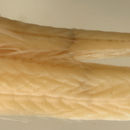pms
nòm ant ël fil


Diagnosis: Long thin larvae with a short round pelvic-fin sucking disk and modal fin-ray counts of D-VI,11 A-11 Pect-20 indicate the river gobies of Sicydium. The taxonomy and range of species in this genus are generally unresolved and numerous species have been described. I follow the recent review for Central America by Lyons (2005). He indicates that S. altum ranges along the coast from Costa Rica through Panama to Colombia, while S. adelum is localized to Costa Rica and S. plumieri and S. punctatum occur in the far east of Panama near Colombia and probably beyond. The remaining Central American species is the northern Sicydium gymnogaster, found only from Veracruz, Mexico to Honduras. There are many other named Caribbean species, some with very restricted ranges, including S. vincente (West Indies), S. caguitae (Puerto Rico), S. montanum (Venezuela), S. buscki and S. gilberti (both Dominican Republic), while S. antillarum is considered widespread.
Description: Body thin, long, and narrow with a medium-sized round eye and a terminal small mouth. Pectoral fins very short, pelvic fins very short. Dorsal and anal-fin bases short and caudal peduncle long and narrowing, 10-14 procurrent caudal-fin rays (this large number shared only with some of the eleotrids). Immature larvae long and thin with Melanophores on the head only along the dorsal edge of the front premaxilla on each side and one midline below the dentary at the tip of the lower jaw. There are ventral midline Internal melanophores are present at the dorsal surface of the swim bladder and around the gut near the vent. melanophores at the base of the upper segmented caudal-fin rays (an unusual pattern for gobiid larvae). There is a large and characteristic internal melanophore at the mid-body above the anal fin that extends in long dendritic filaments up to the surface and along the skin (usually towards the head). Mature larvae are large and stout with a rounded cross-section. The pelvic fins are very short and rounded with an obvious frenum. Mature larvae retain the melanophore patterns of immature larvae, but the melanophores along the ventral midline are present at the pelvic-fin insertion and behind the pelvic-fin insertion, followed by a short row of melanophores along the lateral wall of the abdomen on each side. There is a row of melanophores along the anal-fin base (variably paired, one per side, more than one per fin ray) and then extending unpaired along the ventral midline of the caudal peduncle ending near the start of the procurrent caudal-fin rays. The melanophores at the base of the upper segmented caudal-fin rays persist and the large internal melanophore remains prominent.